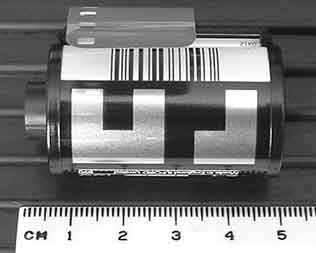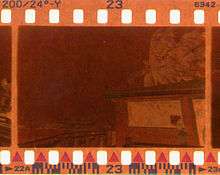DX encoding
DX (Digital indeX) encoding is an ANSI and I3A standard, originally introduced by Kodak in March 1983, for marking 135 and APS photographic film and film cartridges. It consists of several parts, a latent image DX film edge barcode on the film below the sprocket holes, a code on the cartridge used by automatic cameras, and a barcode on the cartridge read by photo-finishing machines.

History
In order to simplify the handling of 35 mm film in 135 format Kodak introduced the DX encoding method on 3. January 1983.[1][2] In contrast to former solutions like Fuji's film speed encoding method in 1977,[3] which was already using electrical contacts for film speed detection on 135 format cartridges,[4] Kodak's later DX code system immediately met success in the marketplace.
The first DX encoded film was the color negative film Kodacolor VR-1000 in March 1983.
The first cameras to use the technology was the Konica TC-X SLR, as well as the compact cameras Pentax Super Sport 35 / PC 35AF-M[5] and Minolta AF-E / Freedom II[6] in 1984. Pentax instead claimed the A3 / A3000 was the first DX-enabled SLR in 1985.[7] Other DX-enabled SLRs were introduced in 1985 as well: Minolta 7000[8] (February 1985) and 9000 (September 1985), as well as the Nikon F-301 / N2000.
DX-iX (data exchange - information exchange) is an expanded DX encoding system introduced in 1996 to be used in conjunction with the Advanced Photo System (APS). It is only used on APS films format IX240, also known as Advantix.
In 1998, Fujifilm introduced a film identification system for 120 and 220 format roll film called Barcode System (with logo "|||B"). The barcode encoding the film format and length as well as the film speed and type is located on the sticker between the emulsion carrying film and the backing paper.[9][10][11][12][13] This 13-bit barcode[9][10][11][12][13] is optically scanned by newer medium format cameras like the Fujifilm GA645i Professional, GA645Wi Professional, GA645Zi Professional, GX645AF Professional, GX680III Professional, GX680IIIS Professional, Hasselblad H1, H2, H2F and H3D Model I with HM 16-32 as well as by the Contax 645 AF.[9]
DX cartridge barcode
Next to the film exit lip is an Interleaved 2 of 5 barcode and a printed number. The 6 digits represent the I3A assigned DX number (middle 4 digits), the number of exposures (last digit) and a proprietary manufacturer's code (first digit). The DX number identifies the manufacturer, film type, and by inference, the necessary developing process type. This is used by automatic photo-finishing machines to correctly process the exposed film.[14]
DX film edge barcode

Below the sprockets under each frame of 135 film is the DX film edge barcode. The barcode is invisible until the film has been developed. It is optically imprinted as a latent image during manufacturing. They are used by photo finishers to identify each frame for printing. It consists of two parallel linear barcodes, one for a synchronizing clock, and the other encoding film data such as type, manufacturer and frame number.[14]
DX Camera Auto Sensing
The outside of film cartridges are marked with a DX Camera Auto Sensing (CAS) code readable by many cameras. Cameras can then automatically determine the film speed, number of exposures and exposure tolerance.
The DX Camera Auto Sensing code takes the form of a grid of contact points on the side of the metal cartridge surface that are either conductive or non-conductive. Electrical contacts in the camera read the bit pattern. Most cameras read only part of the code; typically, only the film speed is read, and some cameras aimed at the consumer market only read enough bits to tell apart the most common film speeds. For example, 100, 200, 400, and 800 can be detected by reading only S1 and S2 and ground.
Electrical contacts
On 35mm film cartridges there are two rows of six rectangular areas. The two left-most areas (with the spool post on the left) are both common (ground) and are thus always bare metal. The remaining five bits in the top row represent 32 possible film speeds. But only the 24 speeds representing the 1/3 stops from ISO 25/15° to 5000/38° are used. The codes are not in strict binary order.
In the second row, the first three bits represent eight possible film lengths, although in practice only 12, 20, 24 and 36 exposures are encoded. The remaining two bits of the second row give four ranges of exposure tolerance, or latitude.
Most cameras read the film speed only (first row).
Diagramatically (with spool post to the left):
| G | S1 | S2 | S3 | S4 | S5 |
| G | L1 | L2 | L3 | T1 | T2 |
Where "G" are the two common-ground contacts, "S" is the film speed, "L" the film length, and "T" the exposure tolerance.
Reading DX Camera Auto Sensing codes
| ISO speed | 1st row DX contacts | |||||
|---|---|---|---|---|---|---|
| G | S1 | S2 | S3 | S4 | S5 | |
| 25/15° | ||||||
| 32/16° | ||||||
| 40/17° | ||||||
| 50/18° | ||||||
| 64/19° | ||||||
| 80/20° | ||||||
| 100/21° | ||||||
| 125/22° | ||||||
| 160/23° | ||||||
| 200/24° | ||||||
| 250/25° | ||||||
| 320/26° | ||||||
| 400/27° | ||||||
| 500/28° | ||||||
| 640/29° | ||||||
| 800/30° | ||||||
| 1000/31° | ||||||
| 1250/32° | ||||||
| 1600/33° | ||||||
| 2000/34° | ||||||
| 2500/35° | ||||||
| 3200/36° | ||||||
| 4000/37° | ||||||
| 5000/38° | ||||||
| custom 1 | ||||||
| custom 2 | ||||||
| custom 3 | ||||||
| custom 4 | ||||||
| custom 5 | ||||||
| custom 6 | ||||||
| custom 7 | ||||||
| custom 8 | ||||||
| Exposures | 2nd row DX contacts | |||||
|---|---|---|---|---|---|---|
| G | L1 | L2 | L3 | T1 | T2 | |
| other | ||||||
| 12 | ||||||
| 20 | ||||||
| 24 | ||||||
| 36 | ||||||
| 48 | ||||||
| 60 | ||||||
| 72 | ||||||
| Exposure tolerance (in f-stops) |
2nd row DX contacts | |||||
|---|---|---|---|---|---|---|
| G | L1 | L2 | L3 | T1 | T2 | |
| ±½ | ||||||
| ±1 | ||||||
| +2 −1 | ||||||
| +3 −1 | ||||||
See also
References
- Kodak press announcement 1-83-1425, 1983
- Kodak press announcement 1-83-1427, 1983
- "US-Patent 4024557: Film magazine having film speed indicating means". Fuji. Patent 4024557. Retrieved 2011-07-21.
- "Fuji's Latest Auto-System". Amateur Photographer: 61. 1977-02-16. Archived from the original on 2018-01-22. Retrieved 2011-07-21.
- "History of Innovations". Pentax. Archived from the original on 2012-03-28. Retrieved 2011-07-21.
1984: Pentax introduces its second leaf-shutter sport model, the Super Sport 35 (PC 35AF-M). The new addition offers all of the features of the Sport 35, plus a built-in auto winder, fully automatic loading and automatic film speed setting using the Kodak-pioneered DX coding system. The Super Sport 35 is the world's first non SLR camera to incorporate the DX film sensing system.
- "Introduction of the Minolta AF-E / Freedom II in July 1984". Minolta camera history. Japan: Konica Minolta. Archived from the original on 2008-03-23.
- "History of Innovations". Pentax. Retrieved 2011-07-21.
1985: The Pentax A3000, a fully automatic SLR, is introduced. Its automated features include: exposure, film loading and winding, and film speed setting with DX-coded film. The A3000 was the world's first 35mm SLR camera to utilize the DX film sensing system. This new SLR also allows for creative flexibility with features such as: aperture-priority, backlight compensation and a 12-second self-timer. The camera's Pentax KA bayonet lens mount makes it compatible with more than 50 Pentax lenses.
- "Introduction of the Minolta 7000 AF in February 1985". Minolta camera history. Japan: Konica Minolta. Archived from the original on 2008-03-23.
- Paul, Matthias R. (2008-08-24). "Infos zu Mittelformatrollfilmen mit Barcodekennung - Barcodes auf Fujifilm Brownies" [Information on medium format rollfilms with barcodes suitable for detection through camera - Barcodes on Fujifilm brownies]. Minolta-Forum (in German). Archived from the original on 2016-08-04. Retrieved 2011-07-21.
- Goto, Shigenori; Hamada, Hisashi; Hashimoto, Shiro; Aoki, Nobuhiro; Sato, Tokuji (2000-02-15) [1996-12-12, 1997-12-09]. "US-Patent #6026250 "Camera, bar code reader for camera and method of detecting bar code reading". Fuji Photo Film Co., Ltd., Fuji Photo Optical Co., Ltd. US6026250A. Archived from the original on 2018-01-22. Retrieved 2018-01-22.
- Goto, Shigenori; Makino, Teruyoshi; Hamada, Hisashi; Sato, Tokuji (2000-04-18) [1997-04-08, 1998-04-08]. "US-Patent #6050489: Bar code system for brownie film and bar code reader of camera". Fuji Photo Film Co., Ltd., Fuji Photo Optical Co., Ltd. US6050489A. Archived from the original on 2018-01-22. Retrieved 2018-01-22.
- Sato, Tokuji; Hamada, Hisashi; Hashimoto, Shiro; Goto, Shigenori; Saito, Tatsuo; Arai, Hiroyuki; Omiya, Akio; Akiba, Makoto (2001-03-27) [1997-05-21, 1998-05-21]. "US-Patent #6208812: Camera with bar code reader". Fuji Photo Film Co., Ltd., Fuji Photo Optical Co., Ltd. US6208812A. Archived from the original on 2018-01-22. Retrieved 2018-01-22.
- Goto, Shigenori; Hamada, Hisashi (2000-04-18) [1996-12-12, 1997-12-09]. "US-Patent #6052538: Camera and exposure control method". Fuji Photo Film Co., Ltd., Fuji Photo Optical Co., Ltd. US6052538A. Archived from the original on 2018-01-22. Retrieved 2018-01-22.
- Kodak US patent 4965628
- Paul, Matthias R. (2005-10-22). "Ausführliche Informationen zum DX/CAS-Code" [Comprehensive information regarding DX/CAS code]. Minolta-Forum (in German). Archived from the original on 2016-03-26. Retrieved 2011-07-21.
External links
- A Java applet for generating and interpreting DX codes at the Wayback Machine (archived 2016-03-04)